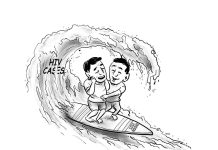
BY JOSE PALU-AY DACUDAO
IN SPITE of the prevailing attitude that such high CO2 atmospheric level and temperature is catastrophic for Terra’s flora and fauna, if one analyses the data, many species indeed died out, but more species evolved. There was a boom in speciation never seen in our present Cenozoic era.
Side note: We can also assume that these are the levels for most of the atmosphere below 100 kilometres high. The reason is that atmospheric gases distribute evenly below this height (fittingly called the homosphere) because the air is turbulent enough to mix them up efficiently.
This is also shown by studies on the moderately long-lived Carbon radioisotope, C-14. Produced mostly in the stratosphere by Nitrogen-14 when it captures a neutron from cosmic ray spallation, C-14 quickly oxidizes into CO2. There is around 70 tons of 14CO2 in the atmosphere in near equilibrium. Most studies agree that in a few weeks, it can be found distributed more or less evenly throughout the homosphere. There were studies on 14CO2 because the atmospheric nuclear tests by the nuclear superpowers in the 1950s to the early 1980s caused a spike in C-14, which was detected through its 14CO2 compound. A nuclear explosion emits massive loads of neutrons, almost every one of which will react with an N-14 atom in diatomic N2. N-14 has a large cross section for neutron capture if done in the atmosphere to form C-14. The nuclear reaction goes as follows: 14N (n, p) 14C.
Specifically, 14N (7 neutrons and 7 protons) + neutron → 14C (8 neutrons and 6 protons) + 1H (protium)
Even now, the generation that grew up in this era of atmospheric nuking has more radioactive C-14 in their bodies compared to the previous ones. Few can scare people more than the thought of inhaling a radioactive gas. Fortunately, with the stoppage of atmospheric nuclear testing, C-14 has gone down nearly to its 1940s level, which we can assume is the natural equilibrium for this radioisotope.
(Side note 2: When life started on Terra almost 4 billion years ago, the primordial radioactive nuclides of Thorium, Uranium, Plutonium, Potassium, and so on, had not yet decayed much, resulting in a background radioactivity of at least a hundred times that of today’s. When mammals first evolved nearly 200 million years ago, background radioactivity was still much higher than today’s, and definitely higher than that emitted by atmospheric 14CO2, even after the atmospheric nuclear tests of the 1950s to 1980s. We can take solace in the fact that mammals probably evolved in such highly radioactive environments compared to today’s, and therefore we probably have inherited some resistance to radioactivity.)
This is an important concept because all elements and compounds in the atmosphere have a natural equilibrium to which they tend to return to once artificial manmade influences are minimized or reduced. Thus, once man-made CO2 production is reduced, atmospheric CO2 will tend to go back to its preindustrial level of below 300 ppm.
There is a strong clear indication that this will happen. (To be continued)/PN







